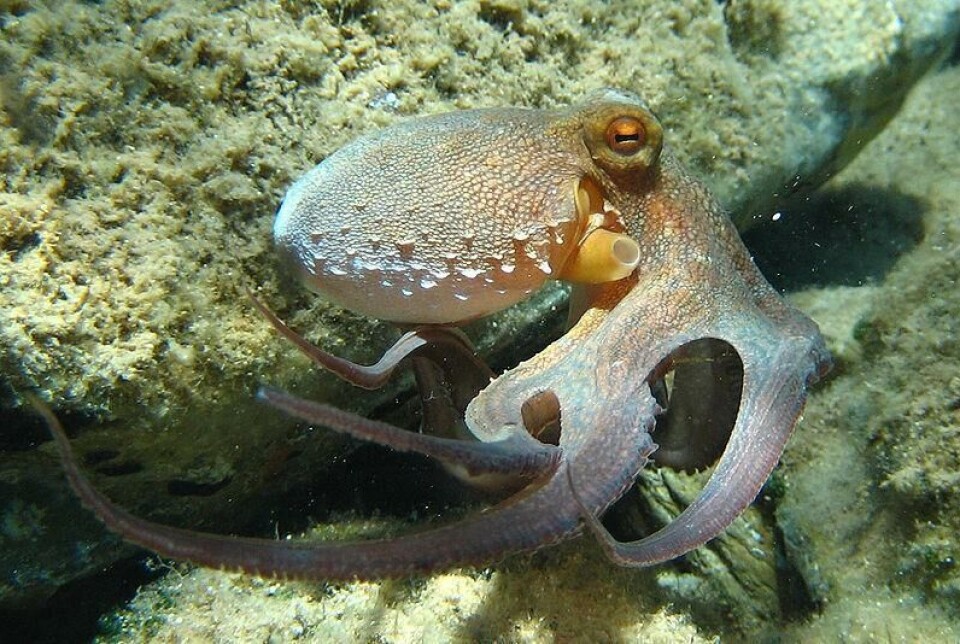THIS ARTICLE/PRESS RELEASE IS PAID FOR AND PRESENTED BY UiT The Arctic University of Norway - read more

What makes an octopus so intelligent?
Octopuses have been shown to solve problems and unscrew the lid of a jar to get food. But how are they able to do such incredible things? Researchers may have found the answer to this conundrum.
DNA is the genetic material found in all cells. The material is passed on or inherited from one generation to the next. The DNA in the cells forms a gene, the recipe for how people, animals or plants should look and function.
It could, for example, be the colour of a flower or a person's blood type. Combined, the DNA forms the entire genetic material in an organism, and is called a genome. The genome contains, in a sense, the entire cookbook with all the recipes for making a human, an animal or a mushroom.
About 20 years ago, scientists managed to put together the entire cookbook of all DNA recipes to make a human – the human genome. And after this, the researchers have managed to collect the genomes of 6,500 animals from all over the world, so that we now know all the recipes for all the characteristics of these animals.
These complete genomes allow us to compare different organisms to learn about the molecular basis of an endless variety of animal forms.
“Despite initial expectations, these genomes show that animal DNA is strikingly similar among different species. For example, a sponge in the sea has several genes that are like those of humans, mice or flies,” researcher Bastian Fromm at UiT Norway's Arctic University says.
Therefore, researchers are now trying to find the explanation for the differences in the animal world elsewhere, namely in the RNA in our cells. And what they find is surprising.

Genes switched on or off
RNA are small molecules in the cell that have important tasks in the production of proteins and contribute to which genes are switched on and off in animals. RNA is found in all cells of all organisms, just like DNA. But unlike DNA, which is double-stranded, RNA is single-stranded. RNA is made from recipes in the DNA.
There are several different kinds of RNA in cells. The best known is mRNA which acts as an intermediary between genes and all the characteristics of the individual. When proteins are made in the cell, the gene is first translated from DNA to mRNA. This can lead to new forms of proteins and creates more diverse proteins.
Another type of RNA is called microRNA. This is what Bastian Fromm is researching. He leads a group that studies evolution and microRNA at UiT The Arctic University Museum of Norway. Scientists believe that microRNAs are the molecules responsible for making new and specialised cells, especially nerve cells.
"The RNA, which is called microRNA, functions as light switches, or dimmers that decide on the exact amount of proteins in our cells that determine cell type and the development of complexity," Fromm says.
Until recently, none of these processes had been studied in octopuses, and it was unclear what drives the complexity of the cognitive abilities in this unique animal. The cognitive abilities are the resources in the brain related to thinking and understanding.

The octopus' secret
In a recently study published in Science Advances, Fromm collaborated with colleagues from Ukraine, the UK, Italy, Belgium, the US and Germany to study RNA biology in octopus.
The researchers hoped to find out the secret behind the octopus' behaviour by determining the sequence of the RNA of 18 different tissues and brain areas of a common octopus. This is called sequencing.
“We had a published genome and a few studies looking at some parts of the RNA in octopus, but nothing convincing was out there. Therefore, we decided to study the entire RNA from multiple different tissues at once,” Grygoriy Zolotarov, first author of the study, explains.
Large amounts of microRNA
The first analyses carried out by Zolotarev and his colleagues in the laboratory in Berlin were disappointing. But when Bastian Fromm and his collaborator Kevin J. Peterson from Dartmouth College in the USA began to analyse the microRNA data, the researchers were surprised:
“When we ran our first analyses on the octopus data, we thought there must be something wrong with our equipment. These guys had more microRNAs than birds,” Fromm says.
This explains how it is possible that octopuses are more intelligent than most birds. It appears that the number of microRNAs animals have in their brains determines how intelligent they are. And octopuses have large amounts of microRNA.
"This is incredible, because we know that intelligence has only developed independently twice throughout evolution, and both times it appears to be driven by microRNA," Fromm says.
Studying octopus embryos
“Our analysis confirmed that octopus has the largest expansion of microRNA that we know outside the world of mammals,” Kevin Peterson says.
So, what is this massive microRNA toolkit used for?
Most new microRNAs are expressed in the nervous system of octopus. Which confirms the animal’s high intelligence and ability to learn.
Excited by this observation, the team collected additional data from developing embryos from octopus.
It turns out that embryos have the highest proportion of new microRNAs. This indicates that microRNAs play a central role in creating different types of cells during development, says Fromm.
“This study is a milestone when it comes to understanding the complexity of organisms and confirms that shining the spotlight on microRNAs for future research is useful for understanding more about why animals are so incredibly different,” Fromm says.
Reference:
Zolotarov et al. MicroRNAs are deeply linked to the emergence of the complex octopus brain, Science Advances, vol. 8, 2022. DOI: 10.1126/sciadv.add9938

This article/press release is paid for and presented by UiT The Arctic University of Norway
This content is created by UiT's communication staff, who use this platform to communicate science and share results from research with the public. UiT The Arctic University of Norway is one of more than 80 owners of ScienceNorway.no. Read more here.
See more content from UiT:
-
AI can help detect heart diseases more quickly
-
Why does Norway need its own AI law?
-
Researchers reveal a fascinating catch from the depths of the sea
-
How can we protect newborn babies from dangerous germs?
-
This is how AI can contribute to faster treatment of lung cancer
-
Newly identified bacterium named after the Northern Lights is resistant to antibiotics




































